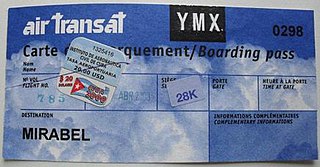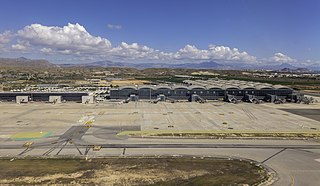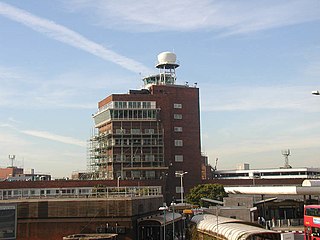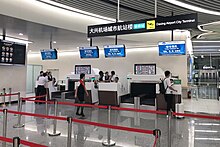
Helsinki-Vantaa Airport, or simply Helsinki Airport, is the main international airport of the city of Helsinki, its surrounding metropolitan area, and the Uusimaa region in Finland. The airport is located in the neighbouring city of Vantaa, about 5 kilometres (3 mi) west of Tikkurila, the administrative centre of Vantaa and 9.2 NM north of Helsinki's city centre. The airport is operated by state-owned Finavia. The facility covers a total of 1,800 hectares of land and contains three runways.

Checked baggage is luggage delivered to an airline or train for transportation in the hold of an aircraft, storage on a coach bus or baggage car of a passenger train. Checked baggage is inaccessible to the passenger during the flight or ride, as opposed to carry-on baggage.

A low-cost carrier or low-cost airline (LCC), also called no-frills, budget or discount carrier or airline, is an airline that is operated with an emphasis on minimizing operating costs. Without some of the traditional services and amenities of traditional airlines, it allows lower fares though provides fewer comforts. To make up for revenue lost in decreased ticket prices, the airline may charge extra fees such as for carry-on baggage. As of April 2020, the world's largest low-cost carrier is Southwest Airlines, which operates primarily in the United States, as well as in some surrounding areas.

Launceston Airport is a regional airport on the outskirts of Launceston, Tasmania. The airport is located in the industrial area of Western Junction 15 km (9.3 mi) from Launceston city centre. It is Tasmania's second busiest after Hobart Airport; it can also run as a curfew free airport.

Doha International Airport is an airport in Doha, Qatar. It was Qatar's commercial international airport until Hamad International Airport opened on 27 May 2014. While all scheduled commercial traffic ceased, the airport site and existing runway are still used by Qatar Emiri Air Force, Qatar Amiri Flight, Rizon Jet, Gulf Helicopters and Qatar Aeronautical College. It also acts as a state/diplomatic airport catering to both Qatar Amiri Flight and state-visit flights. The airport welcomed commercial flights again on 15 September 2022 for selected airlines to handle increased traffic for the 2022 FIFA World Cup that Qatar hosted in November.

In airport terminals, a baggage reclaim area is an area where arriving passengers claim checked-in baggage after disembarking from an airline flight. The alternative term baggage claim is used at airports in the US and some other airports internationally. Similar systems are also used at train stations served by companies that offer checked bags, such as Amtrak in the United States.

Business class is a travel class available on many commercial airlines and rail lines, known by brand names which vary, by airline or rail company. In the airline industry, it was originally intended as an intermediate level of service between economy class and first class, but many airlines now offer business class as the highest level of service, having eliminated first class seating. Business class is distinguished from other travel classes by the quality of seating, food, drinks, ground service and other amenities. In commercial aviation, full business class is usually denoted 'J' or 'C' with schedule flexibility, but can be many other letters depending on circumstances.

A boarding pass or boarding card is a document provided by an airline during airport check-in, giving a passenger permission to enter the restricted area of an airport and to board the airplane for a particular flight. At a minimum, it identifies the passenger, the flight number, the date, and scheduled time for departure. A boarding pass may also indicate details of the perks a passenger is entitled to and is thus presented at the entrance of such facilities to show eligibility.

An electronic ticket is a method of ticket entry, processing, and marketing for companies in the airline, railways and other transport and entertainment industries.

In aviation, aircraft ground handling or ground operations defines the servicing of an aircraft while it is on the ground and (usually) parked at a terminal gate of an airport.

In the airline industry, a baggage handler is a person who loads and unloads baggage, and other cargo for transport via aircraft. With most airlines, the formal job title is "fleet service agent/clerk", though the position is commonly known amongst airline employees as a "ramp agent", due to the job's location on the airport ramp (tarmac).

The term hand luggage or cabin baggage refers to the type of luggage that passengers are allowed to carry along in the passenger compartment of a vehicle instead of a separate cargo compartment. Passengers are allowed to carry a limited number of smaller bags with them in the vehicle, which typically contain valuables and items needed during the journey. There is normally storage space provided for hand luggage, either under seating, or in overhead lockers. Trains usually have luggage racks above the seats and may also have luggage space between the backs of seats facing opposite directions, or in extra luggage racks, for example, at the ends of the carriage near the doors.

Check-in is the process whereby people announce their arrival at an office, hotel, airport, hospital, seaport or event.

Alicante–Elche Miguel Hernández Airport, , is an international airport located about 9 km (5.6 mi) southwest of the city of Alicante and about 10 kilometres east of the city of Elche in Spain. Alicante–Elche is one of the main airports in south-eastern Spain, serving both the southern part of the Valencian Community and the Region of Murcia.

The 2006 transatlantic aircraft plot was a terrorist plot to detonate liquid explosives, carried aboard airliners travelling from the United Kingdom to the United States and Canada, disguised as soft drinks. The plot was discovered by British Metropolitan police during an extensive surveillance operation. A number of security measures were taken in response to the 2006 transatlantic aircraft plot.
Boarding is the entry of passengers onto a vehicle, usually in public transportation. Boarding starts with entering the vehicle and ends with the seating of each passenger and closing the doors. The term is used in road, rail, water and air transport.

Premium economy class, also known by brand names which vary by company, is a travel class offered on many airlines. It is usually positioned between standard economy class and business class in terms of price, comfort, and available amenities. In 1991, EVA Air was the first to introduce Evergreen Class, becoming the first airline to offer this class of service. It was widely acknowledged that the premium economy class has become a standard reflection of what the economy class was like several decades ago. In some countries, this class has emerged as a response from governments and companies requiring economy class for travel done by staff.

On the commercial transportation, mostly with airlines, the baggage allowance is the amount of checked baggage or hand/carry-on luggage the company will allow per passenger. There may be limits on the amount that is allowed free of charge, and hard limits on the amount that is allowed.
Dubai International Airport Terminal 3 is an airport terminal at Dubai International Airport serving Dubai, UAE. When completed and opened on 14 October 2008, it was the largest building in the world by floor area and is currently the world's largest airport terminal, with over 1,713,000 m2 (18,440,000 sq ft) of space. The partly underground Terminal 3 was built at a cost of US$4.5 billion, exclusively for Emirates and has a capacity of 43 million passengers. However, it was announced on 6 September 2012 that Terminal 3 would no longer be Emirates exclusive, as Emirates and Qantas had set up an extensive code sharing agreement. Qantas would be the second and only one of two airlines to fly in and out of Terminal 3. This deal also allows Qantas to use the A380 Dedicated Concourse A. The terminal has 5 Airbus A380 gates at Concourse B, and 18 at Concourse A.. In December 2018, flydubai commenced flights from Terminal 3 to selected destinations to facilitate transfers to/from Emirates. As of 6 March 2023, coinciding with the launch of inaugural non-stop services from Newark as well as a partnership with Emirates, United Airlines began operating out of Terminal 3, becoming the third carrier to do so. On July 26, 2023, Air Canada shifted their service from Toronto-Pearson over from Terminal 1 to Terminal 3 as part of their extensive partnership with Emirates, becoming the fourth carrier to operate out of the terminal.

Basic economy class is a travel class offered by a number of airlines. The class has superseded economy class as the cheapest airfare option for passengers and generally comes with more restrictions when compared to standard economy fares. Restrictions vary between different airlines, but they generally include not allowing passengers to change or cancel tickets or select seats for free. They are seen as a strategy for market segmentation.
























